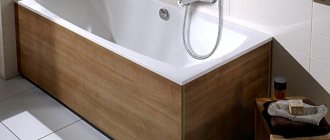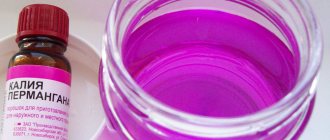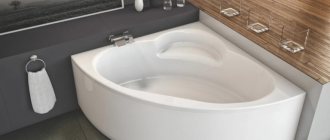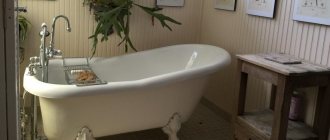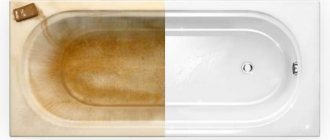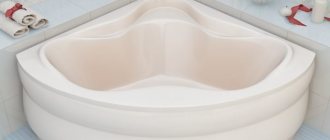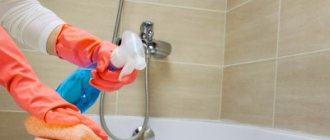You can achieve sparkling white bathtubs if you know the tricks and use the right products to remove different types of stains. So, cast iron cannot be washed with bleach or rubbed with a hard sponge, but the usual “old-fashioned” methods with ammonia, salt, vinegar and lemon will help you easily get rid of rust.
It should be borne in mind that an unpleasant color is only half the problem; in addition to the ugly appearance, such pollution can be dangerous, since pathogenic bacteria multiply in the bath, leading to a number of health problems.
Causes and types of bath contamination
There can be several types of dirt on plumbing fixtures:
- Soap residue. It is formed as a result of the use of soap, gels, shampoos, balms, etc. This contamination is quite persistent, so you cannot simply wash it off with water. It can only be removed with cleaning compounds using a brush.
- Rust spots. The yellow coating on the walls of the bathtub is formed due to rust that accumulates in the water pipes.
- Limescale. Causes water that is too hard.
- Colored spots. They appear in most cases when coloring agents are used carelessly, for example, brilliant green, manganese solution, hair dye, etc.
- Dust. When renovating a bathroom, you should take care of the safety of the plumbing by covering it with film. Construction dust settles on the bathtub, after which it is difficult to clean it.
Why does the coating turn yellow?
Reasons for yellowing of the coating:
- Hardness of water. With a high content of calcium and magnesium salts in the water, a thin rough layer forms on the surface of the sanitary bowl. It is more friable than acrylic or enamel, so dirt, pigments and other coloring substances are easily retained in it. The dark film is removed from the bath along with a layer of mineral salts.
- Chlorinated water. Chlorine-containing solutions harm the acrylic coating, reducing its resistance to damage and contamination. Despite the low chlorine content, water saturated with it negatively affects the condition of the surface. It is especially dangerous for thin plastic liners and coatings formed from liquid acrylic.
- Rust in water. Corrosion of pipes in the general house system, heavy rainfall, repairs of water supply networks and poor water purification lead to an increase in the concentration of iron oxides. Rust gives the water a yellow tint and settles in limescale, pores and microdamages in the coating. Yellow or orange streaks may appear due to oxidation of the metal structure on the bowl (for example, the mesh on the overflow hole). Rust spots appear around deep scratches on the surface of steel and cast iron bathtubs.
- Soap and dirt deposits. If you do not wash and dry the bathtub after each use, a layer of skin particles, dirt, sebum and soap will form on its surface. Mixing with mineral salts, organic waste forms a durable film of gray or yellowish color.
- The use of products with natural or synthetic pigments. Hair dyes, tonics, coloring masks, henna and herbal infusions can turn the coating yellow, light brown or rusty. Decoctions of oak bark, saffron, turmeric, onion peels, walnuts, etc. have strong coloring properties.
Improper surface care (abrasive cleaning, use of acids and alkalis) damages the coating and accelerates the formation of plaque. Strong reagents can quickly clean off any dirt, but complicate cleaning in the future.
Preparing to clean the bathtub: important nuances
Before washing the bathtub from stubborn dirt and plaque at home, it is necessary to carry out preparatory measures and study all the intricacies. When choosing a cleaning method, it is important to consider the type of coating. The reaction of materials to cleaning agents varies markedly.
The following features need to be taken into account:
- You should not experiment with an acrylic bathtub, so as not to harm the outer glossy layer. It is forbidden to rub the bowl with metal brushes and hard sponges, as well as to use products with aggressive components.
- There are products designed for gentle cleaning. They are used for daily treatment so that the bath is always in good condition, but they cannot cope with old stains.
- Aggressive compounds, if used inappropriately, can lead to the destruction of the enamel or acrylic layer after several uses.
Cast iron bathtubs are considered more resistant to various types of influence. But even here it is important not to overdo it. Acidic substances must be used in doses, and a metal brush should not be used at all.
The most sensitive to dirt and household chemicals is acrylic. The material quickly absorbs dyes and is highly susceptible to mechanical stress.
Preparation
Before you rush into the embrasure and attack the bowl with all sorts of powders, gels and acids, you need to find out two things: what material is your bathtub made of and what caused the contamination.
The first will help you choose the right products that will not damage the surface. For cast iron, acrylic and steel appliances, different methods must be used. And here you should be very careful and attentive, including when choosing household chemicals. Since not every bottle labeled “Bathroom” is suitable, the composition must be developed for a specific material.
You need to be even more picky about people's advice and recommendations from forums. Because the stain can be washed off, but how will the material react to this, and will it be necessary to change the font after a year or two of such use? This is a big question to which no one is likely to give you a guaranteed correct answer.
The reasons for contamination can be different: you washed colored linen and the paint was absorbed into the pores, you haven’t cleaned the device for a long time and there is an “indelible” edge, a metal object has been lying on the edge for a long time and rust remains. Each of these problems may require an individual solution.
The most common reasons are:
- Poor water quality - high salt content forms limescale deposits.
- Condition of communications - rust in the pipeline leaves its traces.
- The use of various hygiene products - soap, shower gel, shampoo - forms a soapy layer, which gradually turns into difficult-to-remove stains.
Cleaning a cast iron bathtub
During use, old plumbing develops microcracks into which dirt is embedded. For this reason, cleaning a cast iron bathtub must be done frequently and with great effort.
Modern cast iron bowls are more practical because they have a special coating. Plumbing equipment is easy to care for - almost all oxygen-containing products can be cleaned.
Below are the most effective folk methods on how to clean a durable cast-iron bathtub until it is snow-white, and in 5 minutes or a little longer.
No. 1. Soda
The folk method has proven itself well.
- Prepare 2 types of soda in advance: baking soda and baking soda. Connect 1 to 1.
- Wet the bath and cover it with the resulting product.
- After 30 minutes, scrub with a washcloth.
- After 40 minutes, rinse with water.
No. 2. Washing powder
A cast iron bowl can be cleaned snow-white with a simple powder.
- The powder is rubbed into the walls of the bath and left for half an hour.
- The loose dirt is removed with a brush and the bowl is rinsed.
No. 3. Ammonia and soda
If you want to quickly clean a cast-iron bathtub from old deposits until white, use regular ammonia at home.
- Make a solution by mixing ammonia with soda (1 to 2).
- Apply to the walls of the bathtub.
- After half an hour, scrub and rinse.
No. 4. Vinegar and soda
Another folk method that has gained popularity because it perfectly removes dirt and returns the white color to the bath.
- Combine vinegar, baking soda, liquid cleaner (1:2:2).
- Rub the mixture into contaminated areas.
- Leave for a third of an hour, then remove with water.
Recommendations
- After the manipulations, the bowl must be washed with water and dried, wiping with a cloth.
- If the surface has microcracks, it is recommended to restore the plumbing, since in this case cleaning will not help get rid of stubborn dirt.
How to wash correctly
Regardless of the quality of the coating, the rules for washing a cast iron bathtub are as follows:
- The surface of the new enamel bathtub is non-porous, so it is enough to wash it with special products once a week. For everyday care, available products with a slightly alkaline reaction are suitable: baking soda, laundry soap or dishwashing detergent.
- Detergents are applied from a spray bottle or using sponges, washcloths, and napkins. Light rubbing of the surface with brushes or the hard side of a dish sponge is allowed.
- The method of cleaning an old bathtub depends on the condition of the enamel: if it is satisfactory, then you can use available folk remedies depending on the type of contamination. If the coating is matte and rough, the enamel is damaged, and the plaque can only be removed with aggressive or expensive professional compounds. But such a surface will still become very dirty.
Prohibited means
Common products Belizna, Domestos, Komet, Silit or Bref are aggressive substances with a high concentration of chlorine or acids. They are designed for earthenware and ceramics (i.e. toilets, sinks and tiles) but are not suitable for enameled surfaces. Chlorine really cleans the bathtub white, but regular use of products based on it leads to permanent yellowing of the enamel.
Concentrated acids (oxalic, phosphoric, hydrochloric) damage the structure of the enamel: microcracks appear on it, into which dirt begins to clog. First, the coating loses its shine, then becomes porous and rough. Subsequently, it becomes increasingly difficult to clean such a bathtub, because the destruction of damaged enamel continues, and any contaminants are literally absorbed into it. In especially severe cases, concentrated acids simply corrode the enamel, forming unsightly streaks and exposing the cast-iron base of the bathtub.
Often, even a new bathtub quickly turns yellow due to the high concentration of impurities in tap water, and no “approved” products help restore the surface to its former cleanliness. In such cases, many decide to clean the bathtub with aggressive compounds. This is always a risk for enamel, especially thin-layer enamel. But if you decide to clean yellow spots or rust with such means, it is better to prefer acidic ones to chlorine-containing ones. They should be applied diluted and for the shortest possible time. There is a chance that the product will only have time to corrode the plaque and will not affect the coating. But this method is not suitable for frequent use.
Available means
Homemade recipes for cleaning cast iron bathtubs have been used for a long time, so among them there are many proven and safe products. Many recipes are universal and cope with various stains.
Whitening at home
Vinegar
Table vinegar is a low concentration acid that can safely bleach even an old cast iron bathtub. Used alone or in combination with other home remedies. The most popular and effective recipes:
- "Vinegar bath" 1 liter of vinegar is diluted in a bath with warm water and left for several hours (up to 12). The solution is drained, and the surface is wiped with a sponge and washed with water.
- Compress. Cover the bath with paper towels soaked in vinegar and leave for a long time (optimally overnight). Wipe and rinse with water.
- For whitening old bathtubs and removing stubborn dirt. The bath is moistened with water and rubbed with a mixture of equal parts of baking soda and soda ash, and left for 10 minutes. Mix vinegar and liquid bleach (50 g each). Without washing off the soda, spread the composition over the surface. After 30 minutes, you can rub the bath with a sponge, leave for a few more minutes and rinse with water.
Laundry soap
This remedy is effective on its own or in combination with baking soda. With 72% soap, you can wash a cast-iron bathtub from limescale and yellowness: lather a sponge and treat the surface. Laundry soap is safe for enamel, so you can leave it on for as long as needed, and repeat the procedure if necessary.
You can make a universal washing gel from laundry soap by grating half a piece on a coarse grater, diluting it with warm water and adding 1 tbsp. l. baking soda or soda ash. Baking soda enhances the alkaline effect of soap and helps clean enamel even from stubborn stains.
Oxygen bleaches
These are chlorine-free products that are effective against yellowness. Included in most whitening gels and laundry powders. They can be liquid (active ingredient - hydrogen peroxide) or powder (sodium percarbonate). Does not damage the enamel of cast iron bathtubs. To remove yellow stains, bleaching washing gels or liquid bleach such as Vanish are suitable. The product is distributed throughout the bathroom and left for 15 to 30 minutes and rinsed thoroughly with water. You can follow the instructions on the packaging.
Note: It is important to apply bleaches evenly to avoid bleached streaks and stains. If washing gel is used, it should be of a uniform consistency, without any granules or abrasive.
Toothpaste
Small stains from fresh yellow plaque can be cleaned with whitening toothpaste and an old toothbrush. To enhance the effect, you can add 3-5 drops of lemon essential oil to the paste, which is known for its mild whitening effect. Toothpaste gently polishes the surface of the enamel and gives it shine.
Removing limescale
Lemon acid
An effective limescale remover that acts in the same way as vinegar and can therefore be used as a substitute. Citric acid is mainly available in powder, so it is best to dilute it with water before use to avoid scratching the surface. Goes well with soda.
Ammonia
An alcohol solution of ammonia is diluted with warm water and applied to areas with plaque. Leave for 10-15 minutes and rinse with water.
Note: Liquid formulations are convenient to apply from a spray bottle, but ammonia, when sprayed, gets into the eyes and respiratory tract, causing irritation. Therefore, it is better to apply this solution with a sponge.
Home remedies for rust
Vinegar + sodium tetraborate
Use a mixture of vinegar and borax applied to a sponge to wipe rusty stains until they lighten or disappear. The method is suitable for removing fresh rust.
Vinegar and table salt
Finely ground salt is distributed over the rusty areas. Lay paper napkins on top and use a spray bottle to soak them in vinegar. You can use scrap fabric instead of napkins. The duration of the “compress” is 15 – 30 minutes. Then the salt layer is removed, and the treated areas are wiped with the same napkins or cloth.
Turpentine
Turpentine is used to remove rust that has not yet been deeply ingrained. Thanks to the high concentration of essential oils, turpentine penetrates well into stains and softens them. Used alone or in combination with salt or mustard powder: they are mixed with turpentine to obtain a paste. Apply to the enamel and after 15 minutes try to wipe off the stains with a sponge. If necessary, the exposure time can be extended to 30 minutes. Turpentine polishes the surface and forms a protective film on it, which makes it easier to remove new plaque.
Synthetic detergents
Enameled surfaces are chemically resistant to weak alkalis. Therefore, alkaline-based products are allowed for cleaning cast iron bathtubs. The pH of such products is from 7 to 13. Formulations based on fruit acids are relatively harmless. Chemical products that are safe for enamel baths are represented by the following:
- Oxygen gel Sanelit. Contains low concentration acids, so can be used on enamel surfaces. The antibacterial composition gently and effectively cleans the surface of rust, lime and soap stains. Doesn't always cope with heavy dirt.
Oxygen gel Sanelit. - Sanita anti-rust gel. Suitable for short-term use on enamel. Removes rust, stains, limescale deposits. Leave the product on for up to 7 minutes, then rinse thoroughly. The gel protects the surface from re-formation of rust for several days.
Anti-rust gel Sanita. - Cream Cif Ultra White. It whitens and cleans fresh limescale well, but does not remove rust.
CIF Ultra White - Gel Sanox “Clean Bath”. Eco-product based on fruit acids. Cleans all types of dirt, including old rust.
Sanox bath gel. - Bath gel Sanfor. Professional antibacterial agent for all surfaces. Removes yellowness, rust, lime deposits and prevents new stains for up to 7 days.
Sanfor for baths - Pemolux. Soda-based powder is one of the most popular and effective remedies. Due to its abrasive structure, it is not advisable to often use it on new products, but for old bathtubs it is an indispensable option.
Pemolux - Luxus Professional for baths “Active foam”. Phosphate-free aerosol based on fruit acids, designed to remove all types of contaminants.
Luxus Professional - Sarma bath gel. A universal antibacterial agent without chlorine for all types of contaminants. The product is not recommended for refurbished enamel bathtubs.
Sarma bath gel.
Cleaning a steel bathtub
Steel is practical, but it is not recommended to use abrasive products for cleaning. The steel bowl is sensitive to high temperatures. Keep this in mind when choosing cleaning products. The reagent should not be allowed to heat up in contact with water.
No. 1. Ammonia
To clean the thicket, you need to make a liquid solution.
- Mix 1 tbsp. l. ammonia with 250 ml. water.
- Apply the product to the dry walls of the bath.
- After 10 minutes, the dirt is easily removed; all that remains is to rinse the bowl.
No. 2. Soda
We'll tell you how to clean a (steel) bathtub until it's snow-white in just 5 minutes with regular soda.
- Combine baking soda and water to form a paste.
- Distribute evenly and wait a little.
- Then carefully remove with a soft sponge, avoiding rubbing.
- Wash with water.
Recommendations
- Using traditional methods, wear gloves. If you do not follow the proportions, you can get a chemical burn.
- For steel coating, it is preferable to choose purchased gels. They are distributed and timed for 15 minutes, then removed with water.
- Regular Fairy liquid copes well with daily care.
How to tidy up a cast iron bathtub
Today, cast iron bathtubs are practically not used; they have been replaced by appliances made from more modern and high-tech materials. However, there are those who never want to part with their trusty and time-tested plumbing fixtures, and we must admit that for good reason. After all, cast iron has a number of positive properties, such as high wear resistance, strength, and thermal insulation.
It should be noted that cast iron itself is not afraid of practically anything - no friction, no acids, no scratches or chips. But since it is covered with enamel on top, you should still adhere to some recommendations for caring for this type of bathtub.
The enamel coating of cast iron can be damaged by such agents as chlorine, strong acids, abrasive pastes, gasoline, and even ordinary washing powder, since in this case they are aggressive substances. Each time after use, the bath must be treated with a soapy solution, and then washed with warm running water, finally wiping with a sponge.
To get rid of yellow spots and stains and whiten a cast-iron bathtub, you can use the following means:
- Soda. Mix equal amounts of soda ash and baking soda and apply to the moistened surface of the bath. Keep it for 10-15 minutes. After this, pour an equal amount of vinegar and bleach into a spray bottle, and then spray this solution over a layer of soda, and after about 40-50 minutes, carefully rinse everything off with warm water.
- Table vinegar or citric acid. Dip paper napkins in vinegar or lemon juice solution (at the rate of 10 g of powder per glass of water), then spread them over the entire surface to be cleaned. We wait about an hour and carefully remove them. Sprinkle the most contaminated areas with a small amount of soda, which after 10 minutes is washed off with cool running water.
- Ammonia. In proportions of 1:10 we make a solution of ammonia and water. Apply it using a sprayer or sponge to the entire surface. After 15-20 minutes, wash off the product with running water.
As for household chemicals, one of the most effective and potent products is Domestos. It is he who bleaches the cast-iron bathtub efficiently and for a long time, and also disinfects it. The only drawback of Domestos is its pungent chlorine smell. How to clean the bathtub with household chemicals is described on the label.
Systematic care of your cast iron plumbing will help it maintain its presentable appearance for a long time and be pleasing to the eye.
Important : you should never leave a cast iron bathtub wet, because it is prolonged contact with water that contributes to the appearance of dark spots on it, and subsequently rust. Therefore, after any bath procedure, this sanitary product should be rinsed and wiped dry with a cloth.
Cleaning an enamel bathtub
Plumbing fixtures with such a coating are inexpensive and easy to maintain, which is why they are very popular. But before you clean the bathtub, you need to know one rule in order to carry out the procedure without harm to the enamel.
Avoid using hard brushes and abrasives. They wear away the enamel, the coating becomes rough, and microcracks form. Because of this, the appearance of the bathtub deteriorates, it acquires a yellow coating, and dirt quickly gets into the pores that appear.
What products can be used to clean an enamel bathtub:
No. 1. Lemon acid
To whiten the bath, use regular lemon juice.
- Prepare a high concentration solution based on citric acid.
- Treat the bath.
- Time it for a third of an hour and rinse.
No. 2. Ammonia and soap
Stubborn dirt can be easily removed with ammonia.
- Grate the entire piece of household goods. soap
- Place the shavings in water and leave until a homogeneous mushy state is obtained.
- Add ammonia (5 drops per ½ cup of soap).
- Treat the enamel surface.
- After a quarter of an hour, wipe with a sponge and rinse with water.
No. 3. Soda and peroxide
A popular method will help you clean an enamel surface until it is snow-white.
- 2-3 tbsp. l. mix soda with 250 ml. hot water.
- Add 50 ml. peroxide.
- To achieve snow-whiteness, you can add washing powder.
- After applying the composition to the walls, the dirt is easily separated.
- All that remains is to rinse the bowl with water.
Reviews
Alina, 20 years old. I recently got married, my husband and I moved into my grandmother’s old apartment. The bathtub was in a deplorable state. My mother recommended a tried and true remedy: whiteness. But I found a detailed article on the Internet. From it I learned that soda is also used quite actively for cleaning the bathroom. I washed all the plumbing with a mixture of baking soda and citric acid. The result simply shocked me. The old bathtub shone like a freshly minted coin!
Anna, 40 years old. I always buy Domestos at the supermarket. A week ago I decided to completely redo my bathroom. The cleanser ran out at the most inopportune moment: I didn’t have time to clean the dark stain on the bathtub. Ordinary food water with vinegar helped me. The stain disappeared as if it had never existed. Now I'll wait to buy new plumbing fixtures. I’d rather order an elegant, fitted coat from a fashion catalogue, which I’ve been dreaming of for a long time.
Secrets of cleaning the iron using soda.
Cleaning an acrylic bathtub
Caring for acrylic bathtubs is not as difficult as it might seem. You just need to take into account that not all means are allowed to be used. Some of them can lead to irreversible damage to the coating, as a result of which contaminants will be absorbed into microcracks.
What not to do when caring for an acrylic bathtub:
- clean with products containing low-abrasive substances - after using powders, microcracks may appear, the coating will cease to shine and become dull;
- use chlorine-containing products that corrode the coating, making it rough;
- clean with hard brushes;
- clean the bowl with solvents, for example, acetone or oxalic acid, as they can lead to surface deformation;
- You should stop using formaldehyde and ammonia; an acrylic bathtub is too “delicate” for these substances.
In addition to the above reagents and abrasive components, acrylic plumbing is dangerous: alcohol, gasoline, acids, alkalis. When interacting with them, the color of the coating changes and microcracks form.
The list of restrictions is quite large, but for delicate coatings you can also find safe cleaning products at hand:
No. 1. Vinegar
It will not be possible to clean a bathtub with an acrylic coating until it is snow-white in 5 minutes, since after treating with vinegar you need to wait time. But the effect will impress you.
What should be done:
- Soak paper towels in the vinegar solution.
- Place on the walls and leave for a couple of hours.
- Finally, rinse with water.
No. 2. Lemon acid
Lemon helps maintain whiteness, removes yellow marks and old plaque.
- Fill the bath with water and pour acid (for 200 liters you will need 50 grams of lemon).
- After 2 hours, drain the water.
- Clean the plumbing fixtures with a sponge and wipe with a rag.
No. 3. Toothpaste
To quickly remove yellow stains and bring the bathtub to snow-white, use a paste or diluted powder to clean your teeth.
- Apply toothpaste in a 2 mm layer. on the walls of the bath.
- Detect for half an hour or longer if the dirt is ingrained and old.
- When the allotted time is up, rinse with water.
No. 4. Soda
This folk method involves using not soda itself, but a solution prepared from it with the consistency of a cream.
- Dilute the baking soda with slightly warmed water and allow the grains to dissolve.
- Next, add grated household ingredients. soap.
- Apply to the walls and bottom of the bathtub.
- After 30 minutes, rinse to remove dirt.
You can add aroma oil to the composition - the plumbing fixtures will not only become snow-white, but will also smell pleasant.
No. 5. Peroxide
An effective, but radical method, which is used when it is necessary to urgently clean the bathtub from stains.
- Prepare a solution of ammonia and peroxide (2:1).
- Wet the sponge and distribute the solution onto the stains.
- After 10 minutes, rinse with water. You can't hold it longer.
Ammonia should only be used in extreme cases. Interaction with this substance leads to damage to acrylic.
Care and prevention
With proper care, the guaranteed service life of a cast iron bathtub reaches 25 years or more. To truly appreciate the reliability of such products, you should take into account the rules of their operation:
- After each use, rinse the bath with cold tap water - it contains fewer impurities than hot water.
- It is advisable not to allow water to dry out on the surface for a long time. To do this, it is recommended to wipe the bathtub dry after each use.
- Monitor air quality: high humidity promotes the formation of rust on plumbing fixtures. It is advisable to organize forced ventilation in the bathroom and keep the room doors ajar more often.
- Eliminate leaks in taps, mixers, and shower hoses in a timely manner: dripping water gradually forms yellow or rusty streaks on surfaces.
- Periodically change the position of the gander in the bathroom so that the water does not constantly flow to the same place.
- Make sure that the shower head is completely empty: after use, there is often water left in it, which can drip down in drops for up to several hours. After a few days, traces of these drops will appear in the form of yellow streaks, often with a limescale deposit. Most modern faucets have a function for draining water from the shower head (often this can be achieved by setting the switch to the neutral position).
- When making repairs, you cannot use the bathtub to drain consumables. It can be very difficult to clean a product after repair, so the surface should be protected from glue, sealants and mortars.
Advice! If you need bathroom renovation specialists, there is a very convenient service for selecting specialists from PROFI.RU. Just fill out the order details, the experts will respond and you can choose who to collaborate with. Each specialist in the system has a rating, reviews and examples of work, which will help with the choice. Looks like a mini tender. Placing an application is FREE and does not oblige you to anything. Works in almost all cities of Russia.
If you are a master, follow this link, register in the system and be able to accept orders.
No. 1. Universal products for daily bathroom care
This category contains compounds that are used regularly without harm to enamel or any other coating. Universal products are good because they act simultaneously in all directions: they remove yellow plaque, eliminate rust and other contaminants that tend to eat into the surface.
Sanelit
A budget product in the form of a gel with a whitening effect has proven itself to be excellent. The composition contains active oxygen and fruit acids, thanks to which Sanelit removes almost all types of dirt (soap stains, rust and limescale).
The undeniable advantage of the product is its versatility. It is used on all surfaces, including acrylic, enamel, and plastic bathtubs. The product also removes stains on chrome products and ceramics. There is no unpleasant odor and it is quite economical to use.
SunClean
SanClin will help you clean your bathtub until it’s snow-white, removing all dirt in 5 minutes, and carry out basic plumbing care. The product eliminates soap residue, rust marks, and yellowness. The composition does not contain abrasives, acids, or phosphates, so they are allowed to clean acrylic bathtubs, glass and mirrors.
Luxus Professional
The spray product is ideal for use in the bathroom. The products have quality certificates and a lot of positive reviews.
Advantages:
- delicately cares for sensitive enamel and acrylic surfaces;
- after application, it gradually thickens, flows down, and an active cleaning layer forms on the coating;
- quickly removes residual grease, soap residue, limescale and other contaminants.
Made in Germany, the product justifies its price. It destroys bacteria and gives freshness.
Luxus Professional is produced in accordance with eco-technologies. After use, the product decomposes into non-hazardous biological substances.
What is Whiteness intended for and how does it work?
Bleach is a liquid bleaching and disinfectant that is highly effective. Its effect is due to the presence of sodium hypochlorite, or in simple terms, chlorine - an active, strong oxidizing agent, in a concentration of 95.2%.
Whiteness is used:
- for bleaching textile fabrics made of cotton and linen - it eliminates grayness, stains, makes linen snow-white;
- for disinfecting treatment of enamel, porcelain, earthenware, tile, plastic surfaces, metal parts of plumbing.
For some materials it is used undiluted, for others - only in the form of a solution.
No. 2. Household chemicals for cleaning bathtubs from rust
Special products help both clean the bathtub from rust and plaque, and keep the plumbing at home clean for a long time. Household chemicals even remove old dirt, stubborn rust and limescale that cannot be removed by daily care products.
Effective compositions that will return snow-whiteness to the bath:
Sanox gel
The active components in the product help quickly remove rust and old limescale. In just a few minutes the bath will become snow-white again. In addition, the product kills pathogens of intestinal infections.
Sanox gel contains oxalic acid, so it cannot be used on acrylic and enamel. You need to use the product with gloves, the frequency of use is maximum once a week.
Cillit Bang
The cleaning product, known thanks to advertising, removes all types of dirt in a short time. It is used to whiten bathtubs from yellowness and rust. The effect can be achieved thanks to oxalic acid in the composition. Please note that the product has a strong odor.
No. 3. Store-bought bath cleaners for snow-white bathtubs
Let's look at how to clean a bathtub so that it shines white. You can restore the shine and original appearance of your plumbing fixtures using products specially designed for this purpose. They are relatively inexpensive and easy to use at home.
CIF Ultra White
The effective mousse is very popular because it is inexpensive. The composition includes tiny cleaning granules surrounded by bubbles, so that dirt quickly dissolves.
Consumers note the cumulative effect - as soon as you clean the bathtub, it becomes even whiter after each use of the product. The cream does not provoke the formation of scratches and soap stains.
The advantages also include: a pleasant smell, ease of use, elimination of old limescale and dirt.
Bagi Acrilan
It has several actions: removes mold, rusty plaque, stubborn dirt, and pathogenic bacteria. The indisputable advantage of the product is that it allows you to clean the bathtub until it is snow-white quickly, stains disappear in 5 minutes, and the plumbing fixtures acquire a beautiful shine. Among the disadvantages, consumers highlight the high price and surfactant content.
How to clean acrylic at home
Acrylic bathtubs, with their appearance on the market, successfully replaced cast iron bathtubs, which were previously considered the best and were the most in demand. And all this is thanks to the plasticity of the material, which can take any shape, its lightness, high thermal insulation properties, as well as hygiene.
Advice : in order for your acrylic bathtub not to deform and serve you for many years, you should not expose it to high temperatures (acrylic is unstable to them), namely, you should not soak things in boiling water in it, place hot objects on the surface, or smoke in it. in the bathroom.
For a long service life of an acrylic bathtub and maintaining its snow-white appearance throughout this time, it is necessary to correctly select household chemicals that are suitable for this material. It is advisable to wash acrylic products with gentle care products, excluding aggressive ones. You can use dishwashing and shower gels, as well as regular liquid soap. And for cleaning sanitary ware, such specialized products as Acrylan, Cif, Mister Chister, Acryl Star, Acrylic Polish, etc. are perfect.
It is also necessary to follow the correct procedure for washing acrylic bathtubs. A step-by-step description of this process is presented below:
- First, you will need to moisten the surface of the product with warm water, since you cannot clean an acrylic bathtub dry, so as not to damage it.
- Next, you need to put on gloves and precisely apply the detergent to particularly dirty areas, as well as to a sponge or soft cloth.
- We distribute the product over the entire plastic surface, paying special attention to areas with the most persistent stains, which can be additionally sprinkled with alcohol, lemon juice or vinegar.
- Leave the treated acrylic bath for about an hour.
- After this time, thoroughly rinse off all products and wipe the surface dry with a clean soft cloth.
If you own an acrylic whirlpool bathtub, then this product must be washed as follows:
- Take warm water and stir the detergent in it. Run the hydromassage function for about 15 minutes.
- Turn off the system and leave the cleaning solution for another 10 minutes.
- Next, drain the washing mixture and collect clean water without adding any drugs to it. Start the hydromassage again for 5 minutes.
- Then drain all the water and wipe the bathtub dry.
The Jacuzzi requires mandatory care after each use, which consists of rinsing and then completely drying the surface with a lint-free cloth. Also, to prevent the formation of scale and the accumulation of contaminants, monthly and annual maintenance of this equipment is required, which is most often performed by specialists.
Important : in order not to clog the hydromassage system, this function should be used without bath gels and foams. This will help maintain the technical health of your device for a long time.
No. 4. The safest bath cleaners
In homes where small children or people with allergies live, it is recommended to clean the bathtub with hypoallergenic products. They are made from biodegradable ingredients and natural substances.
Frosch "Green Grapes"
Based on grape acid and tensides. The spray does not have a strong odor, and the bottle has a child safety lock. Frosch is often purchased by allergy sufferers, asthmatics and those who prefer environmentally friendly products. To whiten the bathtub, the emulsion must be applied for 10-30 minutes, depending on the nature of the contamination.
Amway Bathroom Cleaner
Before you whiten your bathtub from yellowness using available methods at home, read about the effective composition from Amway. The Belgian company produces safe cleaning products. The gel does not contain acids or chlorine and can be used for daily care. There is no pungent odor and no harm to the coating.
Astonish paste
The paste is intended for the care of kitchen surfaces, but it is often used in the bathroom. Contains soap and mild abrasives.
Advantage:
- effective and gentle action;
- affordable price;
- high quality;
- efficiency.
Astonish paste is difficult to find in regular stores; it can be ordered online.
How to keep your bath white after cleaning: useful tips
To keep your plumbing fixtures clean and shiny longer, and to avoid having to get rid of old stains, pay attention to the following tips:
- It is recommended to clean the walls of the bowl with a damp, soapy cloth after each use, and then rinse with warm water.
- After use, wipe the plumbing fixtures dry.
- To avoid rust, you must ensure that there are no leaking taps.
- Do not use metal sponges, hard brushes or powders with hard granules for cleaning. Do not scratch the surface - the more microcracks on the bowl, the faster dirt will appear on it, which is difficult to wash off.
- If the bathtub is used for washing metal products or bathing pets, to protect the coating from scratches, a special rubber mat should be placed on the bottom.
- If it is not possible to wash and wipe the bathtub every day, it is recommended to apply a glass cleaner, for example, Amway, Tilex, Titan, to the coating. They help break down lime and grease, preventing the formation of dark spots. The disadvantage of such products is the constant smell of chemicals in the bathroom. This recommendation is only useful to people who take a shower and do not use the bath.
We've looked at all the possible ways to clean your favorite bathtub until it's snow-white in 5 minutes or a little longer. Of course, it is much easier to prevent the occurrence of persistent stains than to remove them. To maintain the original whiteness, you need to clean the plumbing fixtures once a week with a folk remedy or a store-bought solution.
Bottom line
Everyone knows the wisdom that any problem is easier to prevent, so we adjust our methods of caring for the device so that later we don’t have to shed burning tears over a ruined bathtub.
- After each use, rinse the bowl and wipe dry.
- Wash it every day with a mild specialized composition or dishwashing detergent.
- Remove any dirt immediately, without allowing it to “eat” into the surface.
- Install a pre-filter to remove impurities and rust from tap water.
But if trouble could not be avoided, and unsightly stains, plaque and rust still settled in your font, do not be upset. Now you know what and how to do to make the product white again.
If you have your own bathroom whitening method, then don’t be shy and share your secret in the comments!
